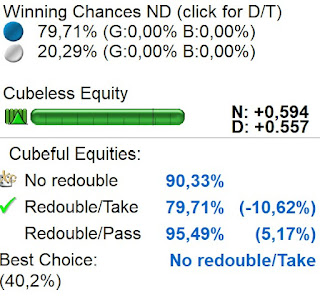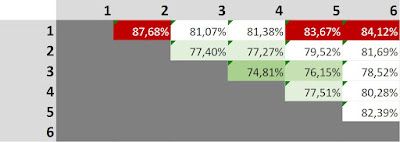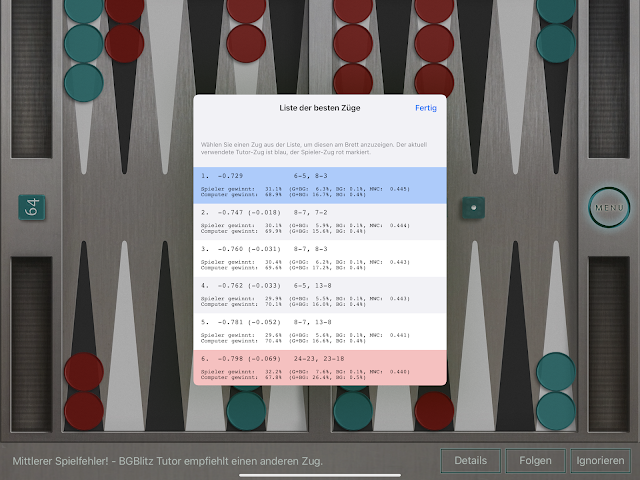Backgammon and its apps (iOS)
Sunday, September 18, 2022
I’m moving!
Sunday, September 4, 2022
How strong is that backgammon app? The big table
Update Sep 8,22: Backgammon KG added (PR 5.7 after 11 games)
Part of my app reviews is a solid test of the respective AI's playing strength. If the app supports it (and a good app should!) I play a couple of matches against it, export them to a file, and let Extreme Gammon 2 (PC) review our match on highest Roller++ level. This should give the reader a good understanding of the app's rating in "PR" (performance rating) points.
Apps that don't support export are harder to rate - I play something like a 3pt match on my iPad and transcribe it simultaneously into XG2, which is an exhausting process. Fortunately the apps that don't export are typically weak, so a rough rating is enough.
So, why not put them all together in a big table for you to compare? Here we go, (iOS) backgammon apps sorted from best to worst.
Please also note: it's difficult to rate the strongest apps; it might be unfair to rate a BGBlitz based app with XG2 only. I'm planning to compare the best 3 or so apps by analyzing a good number of matches with XG2, BGBlitz and GnuBG some day...
About the PR rating
PR ratings reflect how big an error on average you make per move, compared to the optimal move. The lower your PR, the better you're playing. XG uses the following names for the different PR ranges:
- 0,0 - 2,5 = World Champ
- 2,5 - 5,0 = World Class
- 5,0 - 7,5 = Expert
- 7,5 - 12,5 = Advanced
- 12,5 - 17,5 = Intermediate
- 17,5 - 22,5 = Casual Player
- 22,5 - 30,0 = Beginner
- 30,0 and above = Distracted
The arguably strongest human backgammon player, Masayuki Mochizuki ("Mochy") has a PR of slightly above 2. Some sites call an average PR of less than 1.5 “superhuman”, which I’m also doing here.
Friday, September 2, 2022
The most embarassing extracts from the worst match I played in a long time
With the reasoning "if these positions were too difficult for me to find the right move they might also be interesting for you to see" I'm herewith showing you a couple of interesting positions from an embarassingly poor 5pt match I played against True Backgammon (iOS) on BGBlitz-2 (ie superhumanly strong) level.
Enjoy :-)
Things started out poorly in game 1, where I made my first 0.15 blunder in move 2 already. What should I have played here?
I wanted to play 13/11, staying out of direct hit range from his checker on the 4. So I entered on 24, playing BAR/24 13/11.
Obviously, given that white has only a 1 point board, I should have played bold and hit on the 4, accepting the >50% risk (I counted 19/36 hitting numbers) of being hit for the chance of making the 4 point in the next roll. XG2 says the correct move is BAR/24 6/4*, followed by BAR/23, 6/5 (-0.074) and my AR/24 13/11 (-0.145)
Lesson to be learned: play very bold against a 1 point board.
Friday, May 13, 2022
The three difficulty levels of backgammon
Backgammon is not one game, but three games with increasing difficulty level.
LEVEL 1: matches to one point
You and your opponent roll the dice, move the checkers until one of you have won. It’s a tricky game already, with very different strategies to cover holding games, back games and such. If you master it well you’re ready for…
LEVEL 2: money games
LEVEL 3: matches
Sunday, May 1, 2022
Which Back Game is how good?
tl;dr - avoid back games involving the ace point. Seek back games with two consecutive points (eg 34) - better if they are in the middle of your opponent's home board, maybe also with a single point owned by your opponent.
"Which Backgame is how good?" - That's a question I was asking me for a long while? I know, some back games are actually fairly good for the defender. Some are not. But I didn't find good info on the internet.
So I'm trying them all out and log my results here.
I'm using three variations of the same position: one with maximum timing, one with minimum timing, one with a bit more than minimum. It's always white to move, with a roll that doesn't give blue an immediate hit.
There's probably also an "optimal timing" which would be interesting, but which is too much to find out with my limited skills.
So here's the three positions, for an 21 backgame:
(In my "B" positions, blue has a lot of checkers to move before the board starts to crumble. Note that for some back games this is probably too much timing.
And finally, for the "C" position I moved the third checker on 20 in the "A" position to the 11 point for another 9 pips more timing.
If I was analyzing a back game where the blot on 10 couldn't easily move to safety with the 32 roll (e.g. a 54 back game), I changed the roll to 31, and in the special case of a 65 backgame, to 42, so that white always has a roll that doesn't give blue a shot.
For clarity here's position "B" - much timing for a 43 back game.
Findings
More timing, more gammon losses
You don't want a back game with your ace point
- The worst five back games here are the 61, 51, 41, 31, 21 backgames.
Probably you don't want to play a backgame involving your ace point. - your best chances with a back game are the 43, 54, 53 back games.
Good back games: two consecutive points in the middle of your home board.
If you have A LOT of timing, go for at most 1 point between your points
- The best back games are 31, 32, 42, 43, 53 - go for adjacent points or for points with only one point in-between.
- The worst back games are, again, involving the ace point - 21 and 51 (and 61 which we ignore)
The full monty
Disclaimer: I am not good at back games. Watched Michy vs. Dirk yesterday playing a back game on Backgammon Galaxy's YouTube channel. Had no clue why they made some moves. XG2 knows back games, but if I asked it the wrong questions, it certainly gave me the wrong answers.
If you're good at back games and think all this is nonsense, just drop me a comment.
Friday, April 8, 2022
The tutortorial - how to improve your game with the tutor of one of the top backgammon apps
Please note: this blog entry is for beginners who want to improve, not for serious players who know what equities are and how to use them.
Recently on Twitter I suggested to a newbie to use the tutor of True Backgammon to improve his playing strength. And then I realised what a difficult task this will be - the tutors of True Backgammon, XG Mobile, Backgammon NJ all work by throwing a huge number of numbers at you. And you‘re left alone interpreting these numbers.
This is why I‘m writing this tutortorial, a tutorial for the usual tutor. I‘m using True Backgammon and XG mobile as examples. Probably will add other apps (Backgammon NJ in particular) later.
A tiny bit of Backgammon terminology and strategy
It‘s hard to talk about how backgammon tutors work without clarifying some basic terms.
Race: Backgammon is a „racing game“: you roll the dice and race your checkers home, your opponent does the same, and who has them home first wins. If you have less points to cover to come home you‘re ahead in the race. If not, you‘re behind in the race.
Points: a lot of strategy depends on how many checkers you have on a point.
- No checker: both players can still occupy this point.
- * one checker: your checker is a blot that can be hit by your opponent. If he does, it moves to the BAR point, losing all race value it has gained. A blot can be a good thing you create on purpose: if you want to make a point (see below) you can either be lucky and roll a roll that moves two checkers onto that point. Or you risk slotting the point, putting a blot there. If the blot isn‘t hit you can later add another checker to make the point
- * * Two checkers: you have made that point. Your opponent cannot move there, which may hinder him in the race. As you cannot move a checker away from this point without creating a blot such a point is called stripped.
- * * * three checkers: good to have that - you can use one of the checkers to move to another point without giving up that point. This gives your game flexibility.
- * * * * four or more checkers: this point is too crowded, you should think moving checkers away because they serve no purpose in hindering your opponent‘s race.
Pip Count
This is a first tutor-ish feature as the player who is ahead in the race has to do nothing but bring his checkers home safely to win. He should play conservatively, not risk leaving blots. The player that is behind in the race needs to risk something to catch up. He wants to hit a blot or block to the opponent so he can‘t use a roll and falls back in the race.
Now let’s a look at the actual tutor; here‘s a position in which True Backgammon tells me that I‘ve made a mistake.
Tutors are all about equities and probabilities
Race vs equity
The value of a move is how it affects your equity
- I will win roughly 1 in 3 matches from this position (31.1%).
- The computer will win the other 68.9%. There is no draw in backgammon.
- A number that is often helpful is the one named „G+BG“. This number tells you how likely you and your opponent are to win with a gammon or even backgammon. Here, my opponent is fairly safe from gammons, I will only win 6.3% or one out of 15 games by gammon/BG. My opponent is starting to build up some gammon potential with a 16.7% gammon chance, he will win one in 6 games by gammon.
- Ignore the MWC figure for now - these are the match winning chances for me, which is important for match play, because the evaluation of a position might be different if you‘re playing a long match and leading by far or if you‘re playing a normal game.
- My move is only the 6th best move. I managed to not find one of five better moves. Good job.
- The leftmost figure, -0.798, is the equity of the position after my move. In brackets it shows (-0.069) which is the difference to the equity of the best move, ie the equity I‘m losing because I picked the wrong move.
- It then shows my move, 24-23, 23-18
- Below it shows my new winning probability, 32.2%. I‘m 1.1% less likely to win now.
- Also it shows gammon/backgammon probabilities. You can see that my opponent‘s gammon chances have climbed by 10% from 16.7% to 26.4%. That‘s because I‘m leaving two blots for him to hit and build a strong board.
Tutors are no teachers
How to work with a tutor
- If you‘re a beginner, I suggest you focus on blunders that cost you more than 0.3 points of equity. It‘s far easier to find out what you did wrong than in moves that only cost you 0.05 points of equity.
- Tutors often allow you to click on a move and see it on the board. Look at the position after your move and after the bot‘s move. What are the key differences?
- Maybe look at other moves that are also close to the equity of the top move. What do they have in common that your move doesn‘t have in common with all of them?
- Look at the gammon/backgammon percentages. Sometimes a key difference is that you greatly increase the chance of losing two points.
- Oh yes, and please trust the computer‘s evaluation 100%. If you‘re a top player you might know about very, very exotic positions where the bot misanalyzes the position. But a beginner can blindly trust the evaluation of a superhumanly strong player like True Backgammon‘s BGBlitz engine or XG mobile. If the bot says your move is shit, your move is shit. :-)
XG Mobile‘s tutor (which is really the same thing)
Thursday, March 10, 2022
Hardwood Backgammon for iOS - very close, but still no cigar
Imagine you‘re listening to a really beautiful song, and just when it‘s all perfect, the singer takes out his mouth organ and plays a really ugly mouth organ riff. That‘s a bit how I feel about Hardwood Backgammon (HW BG). It has many great features, and should stand out of the large sea of backgammon apps. But one issue nearly kills it for me.
Let‘s start with the positives. HW BG has nice 3Dish visuals on iPhone and iPad, different boards, backgrounds, checkers and dice (and more for money) to choose from, features everything a full backgammon app needs (matches, doubling cube, Crawford rule), and a strong bot to play against.
I’m moving!
Dear reader, While I’m busy moving this site to a new place where I can give you a better overview of the content (and revisiting my reviews...
-
Okay, it's time to also review Android Backgammons. I wiped the dust off my old trusty Galaxy Tab S2, and installed my first Android Ba...
-
Summary: If you don't want to pay just to play a game of backgammon against a good engine, if you want a beautiful UI and a simple multi...
-
Recently I came across this position when playing Gnu Backgammon: White to play 65 I thought that the big decision is: hit with 13/2* ...


























